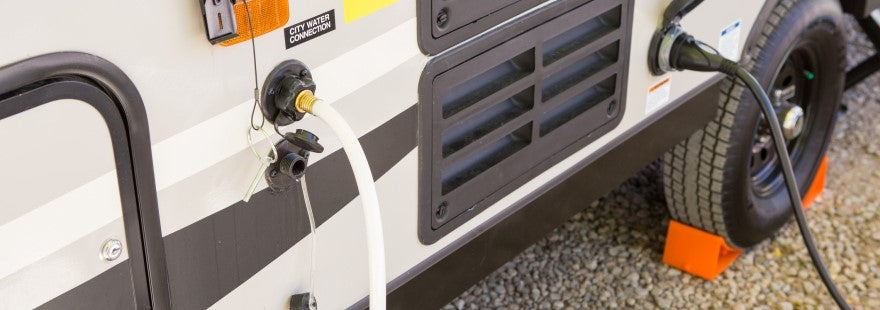We know. Nobody wants to talk about preparing for those long, frigid months of winter when warm summer days are still on the horizon. But now, when the weather is nice and Jack Frost isn’t breathing down your neck, is the time to address RV furnace maintenance.
To ensure your camper furnace is operating properly when you need it most, it’s extremely important to conduct yearly RV furnace preventative maintenance routines. We’re taking a high-level look at some of the crucial maintenance tasks you should be performing on your camper’s furnace on an annual basis.
Please Note: RV owners should never remove any component on a sealed furnace system that is held in place with a gasket. This may result in a carbon monoxide leak. Some of the following procedures require diagnostic equipment and should be conducted by a professional service technician. Consult your manufacturer’s manual for product-specific instructions.
Keep the Furnace Clean
First, you’ll want to wipe down every surface of the furnace that you can easily access. In reality, this is something you should be doing regularly but if you’re not, make sure to give everything a good cleaning on at least an annual basis. Simply keeping your furnace free of dirt and dust can help ensure proper operation.
Next, use your vacuum to clean in and around the furnace compartment, RV furnace filter and floor ducts (as far as you can reach). Then, use a soft, damp cloth to thoroughly wipe down any metal components.
Inspect Your Ductwork & Registers
If your camper is equipped with flexible ductwork, it is typically routed above the floor, inside your cabinets, etc. Since they’re more easily accessible, you’ll want to inspect the routing of each run. But what are you looking for? Keep an eye out for collapsed or pinched ducts or excess branch ducts that can be shortened to eliminate a buildup of heat.
Look for Potential Obstructions
Did you know that creatures and critters can take up residence in your intake/exhaust assembly? This is why you’ll want to do a full inspection of your intake and exhaust vents on the exterior of your RV. Any type of obstruction within the intake tube can cause incomplete combustion while obstructions in the exhaust tube can be a serious fire hazard.
In addition to this, you’ll want to ensure the cutouts in the casing of the furnace that correspond with the minimum return-air requirements are clear of obstructions. The forced-air furnace grill and the area directly behind it should also be clear of obstructions or blockages.
Check the Fuel Supply
When liquid fuel sits in the propane container, it is warmed through contact with the external walls of the container. The container is then heated by the air around it. Because of this, the container’s interior wall needs to be wetted by the liquefied propane in order to vaporize at a rate greater than what the furnace requires. The rate of vaporization fluctuates with the temperature of the liquefied propane and the amount of surface area wetted by the propane. So, as you can imagine, this can be a constant annoyance during winter travel.
To combat this, make an effort to keep your RV’s propane container as full as possible during the colder months.
Verify the DC Voltage Supply
Your RV’s battery system is a vital component to making your entire vehicle run and operate smoothly. Having the right amount of DC voltage means your forced-air furnace is running both safely and efficiently. You typically won’t want to run your battery at below a 50-percent charge unless absolutely necessary. But you also don’t want to pump too high of a voltage into your furnace.
Make sure your furnace is operating at a voltage between 10.5 and 13.5 volts DC. Keeping your camper battery properly charged and clean allows for optimum operation of your furnace.
Replace Your Old Furnace if Needed
Another facet of furnace maintenance is knowing when the end is near. In general, there are seven signs it may be time to replace your RV furnace.
- Your furnace is nearing the end of its lifespan.
- The RV interior gets dirty while the furnace is running.
- You’re hearing loud, unusual noises.
- The RV furnace is rusted or cracked.
- Repair costs are rising.
- The RV furnace is blowing cold air.
- The pilot light is the wrong color.
If your RV furnace is exhibiting one or more of these symptoms, it may be time to replace your old and inefficient unit. At Boat & RV Accessories, we have a wide range of Dometic and Atwood camper heaters to choose from. Be sure to read our RV Furnace Buying Guide to ensure you’re purchasing the right unit for your camping needs.
Once again, this is by no means an exhaustive RV furnace maintenance guide. Be sure to consult your manufacturer’s manual for product-specific instructions.
Shop Boat & RV Accessories for Your New Camper Furnace
Browse Boat & RV Accessories for your camper furnace and camper heater parts. We offer a vast selection to help you fix your RV furnace and keep it in tip-top condition year-round. Have a question or need more information about which furnace is right for your needs?

